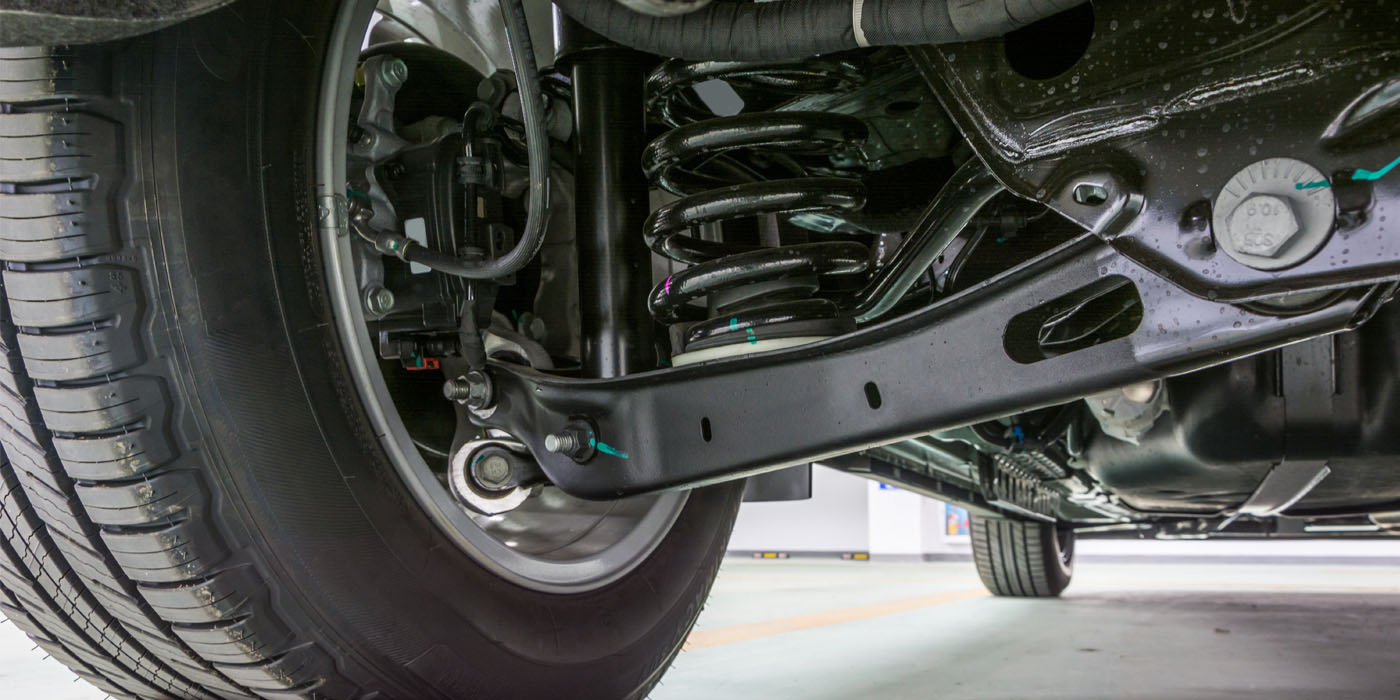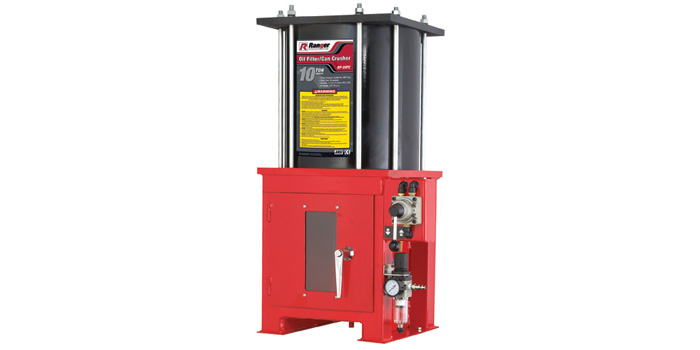The process of aligning a collision-damaged vehicle is much more involved thanperforming a maintenance alignment. If thecustomer hasn’t hit anything, the technician can make many assumptions.But making assumptions about a collision-related four-wheel alignment will put your shop on a crash course.
Ever since rear adjustable suspensions became commonplace in our industry, the argument has raged about when a “four-wheel alignment” is needed, who pays for it and how much it costs. But why?
The following two statements, while absolute, are at times controversial:
- If a vehicle needs a wheel alignment and the rear suspension is independent or adjustable, then the four-wheel alignment process must be used to ensure the vehicle is properly repaired.
- If a vehicle after a collision needs a wheel alignment and even if the rear suspension is “non-adjustable,” then the four-wheel alignment process must be used to ensure the vehicle is properly repaired.
So why all the controversy if this is so clear?
I don’t believe the recent argument has been whether a wheel alignment is necessary — although I can still remember when, if the wheel wasn’t hit directly, “We don’t pay.” Rather, the recent argument has been:
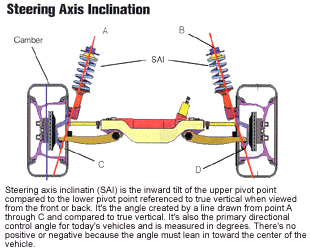
- whether the rear wheels need to be referenced — an argument that generally originates with insurers and repairers who have little knowledge of or concern for proper repair procedures;
- what really constitutes a four-wheel alignment;
- if it’s accident related; and
- how much it will cost.
A number of suspension damage and diagnosis specialists I admire believe the term “four-wheel alignment” shouldn’t be used today to describe what’s necessary. They suggest calling it “structural alignment” or something to that effect. In many ways, I agree. In reality, however, we just don’t change the name of a product or service when it’s been known by that name for so long. And this name’s been around since the 1920s, when John Bean discovered that farm trucks with sprayer units required front suspension adjustments to drive correctly and subsequently designed the wheel alignment system.
Even though collision-related wheel alignment is confused with another type of service of the same name, I think we can share it as long as we understand that the same basic terms may be “apples” and “oranges” when we get down to comparing details.
For instance, take filet mignon and hamburger. We all know the difference, right? But they’re both basically beef. Just because the filet is a higher quality product, we can’t deny it’s still beef, and we don’t try to change the name. The same may apply to four-wheel alignments. There are many different grades of these alignments based on the process required, and we should educate everyone about the differences.
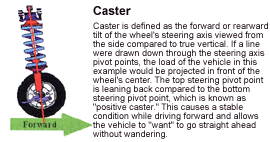
Their Alignments vs. Our Alignments
The first step is to realize that alignments for collision-damaged vehicles aren’t the same as those performed for consumer maintenance alignments. If the customer hasn’t hit anything, then many assumptions can be made by the alignment technician. Suspension parts and structural areas haven’t moved, been damaged or been repaired. The technician normally only looks for “worn” parts. This allows for a low-priced “retail based” alignment process.
I’m sure you’ve heard the phrase, “Set the toe and let ’er go.” On many maintenance-type wheel alignments today, this is very true. Of course, this is where “upselling” occurs for extras like struts, shocks, springs, tie rods, ball joints, etc., for the retail alignment stores. In this kind of retail business model, the alignment pricing is just a “leader item” for the above-mentioned upsells. It’s not at all reflective of what’s required for a collision-related alignment.
In a collision, we can’t assume anything. It’s amazing how the possibility of damaged suspension parts and structural misalignment increases due to an accident as compared to regular use by the customer. In fact, I’m not aware of any insurers who have approved claims for repairs as a result of normal driving; all claims seem to be the results of collisions, fires, thefts and acts of God. So why don’t we recognize there’s a difference in these alignments?
What’s a Wheel Alignment?
The wheel alignment process isn’t to “correct all evils” that were overlooked during the rest of the repairs. This process, at best, is designed to validate what was done during vehicle repairs in regard to structural damages.
When I’m asked what’s included in a four-wheel alignment, I immediately reply, “It’s not just putting the alignment heads on the vehicle, taking ‘run out’ for the wheels and going through the basic caster sweep to get a print out of the vehicle’s condition.” That’s an alignment check — and not even a complete check if the vehicle’s been in an accident. For a collision alignment check, you must check all available alignment angles, not just caster, camber and toe.
A collision wheel alignment is the process of checking all the alignment angles available to ensure that all structural repairs were performed properly and that suspension parts aren’t bent. Then and only then should you perform the “fine tuning” adjustments — as long as they don’t adversely affect another alignment angle.
Collision alignment doesn’t include the installation of any “specialty kits” or parts required for the alignment to be performed. In many cases, these “specialty products” are being used to disguise or mask the real problem area and shouldn’t be used.
Don’t Assume
If a vehicle is in an accident, the location of the mounting points for suspension parts to the frame or body may have moved. The structural technician can’t assume anything here. He must make sure these points are back to their proper pre-accident position. Unfortunately, these points often aren’t the “control points” given in frame specification guides, so this type of confirmation may require taking side-to-side comparisons to determine that the points are “square” within the structure. It may also require measuring alignment angles to identify the misalignment.
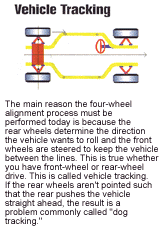
These mounting points — whether upper strut towers, lower cradle mounts or trailing arm mounts — determine many critical locations for suspension parts and have very close tolerance requirements. If you assume anything here, proper adjustment of the suspension can’t be made.
Also, don’t assume that a part is damaged without properly diagnosing it. (Of course, when the suspension part is bent at a 45-degree angle, it may be obvious.) We don’t need to play the “musical replacement game” — replacing parts all at once because we have a “feeling” or one at a time until we get it right. This, by the way, leaves a lot of unnecessary new items on the vehicle. But since they are already on it, who will ever know, right? Wrong!
These assumptions are made too often, usually because we don’t concern ourselves with the vehicle’s alignment until very late in the overall repair process. It’s also due to a serious misunderstanding of symptoms vs. real problems.
A Symptom … Not the Real Problem
Most of us have heard the term “camber,” which is defined as the inward or outward tilt of the tire at the top when viewed from the front or back. This angle in most front and rear wheels needs to be checked and corrected to specification. It may or may not be adjustable, and it’s generally measured in degrees or fractions of degrees.
For example, if a line were drawn through the center line of the tire, that line represents the camber angle when compared to true vertical. If the tire is leaning out at the top (viewed from the front or back), it’s called “positive camber.” If it’s leaning in at the top, then it’s “negative camber.”
Engineers determine what the camber angle should be at rest (static) and during driving (dynamic) to maximize vehicle control and handling. Ideally, all the tire’s treaded surface area would be on the road (0 degrees camber) during driving; this would minimize tire wear and vehicle pulling. But getting the camber angle to stay at zero during all dynamic conditions is almost impossible, since camber changes as the vehicle’s height from the road surface changes. This height change is due to acceleration, braking and slight changes in the road. However, the more it stays at zero the better.
It’s also important that side-to-side (left to right) comparisons of the camber angles are balanced or within manufacturer specifications. Generally, the collision repair industry should ensure that this balance is within one-fourth of a degree side-to-side and that each reading is on the same side of zero (both negative or both positive). This is referred to as the “split” or “cross camber.” Imbalance of camber readings and/or out of specification settings can easily cause the vehicle to pull to the side of most positive (for front wheels and opposite for rear wheels).
But keep in mind that improper camber angle readings are often only a symptom of the real problem. It’s unfortunate the camber is what most alignment technicians “fix” at all costs, even if it dramatically affects other alignment angles. A point I attempt to convey to technicians is that no one should ever sacrifice one alignment angle to fix another. It must be properly diagnosed.
Don’t react to the symptom. Fix the real problem.
Caster — The Forgotten Angle
In the past, caster was used as the primary directional control angle of the vehicle. Caster is defined as the forward or rearward tilt of the wheel’s steering axis viewed from the side and compared to true vertical. It’s normally measured in degrees and/or fractions of degrees. If a line were drawn down through the steering axis pivot points, the load of the vehicle in this example would be projected in front of the wheel’s center. The top steering pivot point leans back compared to the bottom steering pivot point, which is known as “positive caster.” This causes a stable condition while driving forward and allows the vehicle to “want” to go straight ahead without wandering. (Note: The scope of this article isn’t to get into all the dynamics of how caster works on today’s vehicles — there’s much more to this angle — but it’s to make us aware of what we must do during collision repairs to ensure we won’t have alignment problems.)
For many vehicles, there’s no adjustment for this angle. But just because it’s not adjustable doesn’t mean it’s not important. During a collision, it’s easy to see that an impact — such as moving the front structure or suspension mounting areas forward or backward — can affect this angle. The key here is that even if there’s no adjustment or specification, caster must be balanced side to side. Caster split must be balanced to within one-half degree of each other. Any major imbalance will tend to make the vehicle pull to the side of “least caster.”
The Importance of Control Points
A concept normally overlooked by our industry is that the entire structural repair process is designed to restore the vehicle back to not only its pre-accident condition in regard to crash management, dimensions and durability, but also to driveability.
If we all agree with this (if you don’t, please don’t fix my car), then why do we basically ignore the alignment specifications until we’re done with everything, including the paint work? In many cases, we ship the vehicle to the “alignment guy” with our fingers crossed.
Everything we do structurally to the vehicle may affect whether or not the alignment is successful. To ensure success, we must ensure the control points affecting wheel alignment angles are properly measured and verified … every time and before the vehicle leaves the frame rack.
“How, without doing two-wheel alignments on each vehicle?” you may be asking yourself.
With today’s modern measuring equipment and some common sense, this can be verified during the structural repair process.
The factors causing the camber symptoms mentioned earlier are all caused by two other angles (often mysterious to some): steering axis inclination (SAI) and included angle. These are normally referred to as the “diagnostic angles,” but are much more significant than that to the collision repair industry.
If a technician checks the relative location of the upper pivot point and the lower pivot point on both sides of the vehicle and they match, then he’s getting closer to a proper alignment.
Taking the Mystery Out of Diagnostic Angles
I’ve taught hundreds of technicians at diagnostic and alignment classes over the years, and I’m still amazed at their lack of understanding of SAI and IA. These angles are the lifeblood of today’s structural collision repair and wheel alignment.
The first to understand is SAI. It’s the inward tilt of the upper pivot point compared to the lower pivot point, referenced to true vertical when viewed from the front or back. This is the angle created by a line drawn from the upper pivot point to the lower pivot point and compared to true vertical. It’s the primary directional control angle for today’s vehicles and is measured in degrees. There’s no positive or negative because the angle must lean in toward the center of the vehicle.
It’s critical for alignment technicians to provide proper SAI readings for every collision alignment. SAI is the key factor for validating proper structural dimensions in these suspension mounting areas during collision-related wheel alignments.
Unfortunately, most maintenance alignment technicians don’t know how to measure these angles properly. Each system today has a set procedure to perform these measurements; they’re not automatic but are clearly explained in the operation manual or on help screens of today’s alignment systems. Still, many never correctly perform this check. Why not?
The main reason is because retail outlets such as Firestone, Goodyear, etc., perform up to hundreds more maintenance alignments than collision-related alignments per month. They don’t habitually check these diagnostic angles. In fact, they may never have to. This is where they “assume” everything is correct. But if they assume this in a collision wheel alignment, they may attempt to fix a symptom rather than the real problem.
If the structural repairs are completed properly, this angle will be correct, unless a control arm or ball joint stud is bent. If the technician properly verifies the relative ball joint position — they’re not bent on either side — and the mounting location of the control arm relative to each side, then SAI is correct and the structural dimensions are most likely correct as well. If not , there’s a problem.
So what should you do if the alignment guy tells you the car won’t align? The most important question to ask is, “What’s the SAI for both sides, and what are the camber readings for both sides?” With or without specifications (many times SAI specifications aren’t published), this information can lead to a quick diagnosis of the real problem.
The included angle is another angle used to diagnose the location of the real problem. It’s a calculated angle derived by adding the SAI and the camber angle. This angle determines if there’s bent or misadjusted parts between the upper and lower pivot points of the suspension.
Some great programs are available to train you and your staff on this diagnostic method, and I’ve taught many myself. It’s well worth your time and money to understand this diagnosis system since it’s possible your alignment tech doesn’t.
The Rear Leads the Pack
The main reason the four-wheel alignment process must be performed today is because the rear wheels determine the direction the vehicle wants to roll, and the front wheels are steered to keep the vehicle between the lines. This is true whether you have front- or rear-wheel drive. This is called vehicle tracking. If the rear wheels aren’t pointed so the rear pushes the vehicle straight ahead, the result is a tracking problem commonly called “dog tracking.”
This relationship between the vehicle’s geometric centerline and where the rear wheels are pointed is critical for proper performance of restoring the vehicle to pre-accident condition. If the wheel’s thrust (direction of vector created by drawing a line where the rear wheels are pushing the vehicle) isn’t straight ahead, then an angle is formed that’s skewed from the vehicle’s centerline. This is the “thrust angle.” If the rear wheels are pointed parallel to the centerline of the vehicle or equally balanced against each other (keeping within specifications), the thrust angle would be zero — our ideal target. The tolerance for this angle allowed by most manufacturers is very small. In fact, as a general rule, they’re all less than .25 degrees.
Toe is a basic alignment concept for both the front and rear wheels, and it’s the inward or outward position of the tires compared to straight ahead. Total toe is the difference between how far apart the front of the tires are compared to the rear of the tires. For years this was measured by drawing a line around the tire close to the center of the tread, measuring the distance the lines were apart in the front (at spindle height), measuring the distance the lines were apart at the rear of the tires (at spindle height) and then subtracting rear distance from front distance. If the calculation was “negative,” it had “toe-in.” If it was “positive,” it had “toe-out.”
During dynamic conditions (normal driving), the toe will attempt to get as close to zero toe as possible to minimize tire wear and maximize handling and gas mileage. Engineers pre-determine whether a suspension system should begin (static at rest) with positive or negative toe to achieve the best results. Our job isn’t to re-engineer this, but to ensure that it’s possible.
Rear toe settings determine the thrust angle of the vehicle. Unfortunately, total toe can be measured at zero and still have a thrust angle problem. This is why individual toe readings should be taken for each wheel. Today’s alignment systems will provide these readings.
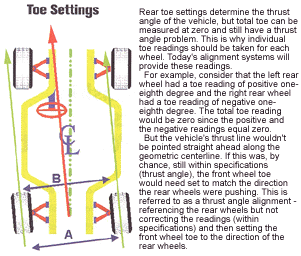
For example, suppose the left rear wheel had a toe reading of positive one-eighth degree and the right rear wheel had a toe reading of negative one-eighth degree. The total toe reading would be zero since the equal positive and negative reading would add to zero but the vehicle’s thrust line wouldn’t be pointed straight ahead along the geometric centerline.
If this was, by slight chance, still within specifications (thrust angle), the front wheel toe would need to be set to match the direction the rear wheels were pushing. This is referred to as thrust angle alignment. The thrust angle alignment is defined as referencing the rear wheels but not correcting the readings (must be within specifications) and then setting the front wheel toe to the direction of the rear wheels.
Why Two-Wheel Alignments Don’t Cut It
If the rear wheels weren’t referenced at all during the alignment process (two-wheel alignments) and the thrust angle isn’t exactly zero, the result is predictable: a steering wheel that’s centered at rest (static) but becomes off-center as soon as the vehicle begins moving. This is because the moment the vehicle moves, the rear wheels will push the back of the vehicle in the direction they’re pointed. The front wheels must now compensate for this and turn toward the same direction. In fact, if the rear wheels are pointed to the right, the vehicle will attempt to drive (roll) left — so the steering wheel will have to turn slightly to the right to keep the vehicle straight on the road.
This, again, is what’s commonly referred to as dog tracking. In years past with solid live axles, the assumption (which was and is still wrong) was that rear wheels had no thrust angle, since it couldn’t be adjusted. (Hopefully when this condition occurred, the customer didn’t have to stop every mile or so to remove bugs from the side windows!)
Today, any wheel alignment process must begin with referencing where the rear wheels are pointed and if the rear camber is correct. If the camber isn’t correct, the rear will pull and cause the vehicle’s steering wheel to again be off-center — even though there’s no thrust angle indicated according to the readings.
Is It Accident Related?
Once the rear wheels are referenced and found to be out of specifications, the queston becomes: Is it accident related?
Keep in mind, camber and toe being out of specification will cause telltale signs of tire wear. Camber will wear the inside or outside of the tire, and toe problems will cause a scuffing of the tread across the face of the tire.
The first question I’d ask is whether the tires are showing these signs at the time of the estimate. Toe problems will generally have an immediate visual effect on the tire, while camber will be more long term. If the tires show no indication of prior tire wear, then it’s likely the misalignment now seen was caused by the accident. If the tires indicate prior and unusual tire wear, then it probably was pre-existing.
In either event, the front and back wheels must be aligned together. Proper communication to the customer is now the responsibility of all parties. You may be doing the customer a favor by giving him a chance to correct the situation now, while you have the vehicle on the alignment rack. But you don’t have to correct the situation if it’s not accident related. You’re only obligated to restore the vehicle back to pre-accident condition — not to fix it “better” than before. I realize we often do this, but it may be necessary to communicate to the customer what to expect in these situations. The customer will naturally assume the wheel alignment will fix any rear pre-existing problems. We need to educate customers. We’ve done it with tires, batteries, etc. Maybe we need to look at alignment in the same light.
Getting It Straight
I hope by now you realize that putting the same price tag on collision-related alignments and most retail maintenance alignments is absolutely absurd. They’re not the same process.
The price tag for a collision-related wheel alignment must be based on work performed. If we only have to reference the rear wheels and don’t have to do anything since they’re correct, the price should reflect that. But if adjustments need to be made, the price should reflect that as well. The idea of a set price for all puts us in a position of “winning some and losing some.” And this isn’t a good position for our industry’s future.
Contributing editor Tony Passwater is president of AEII, a consulting, training and system-development company. He’s been in the industry for more than 27 years; has been a collision repair facility owner, vocational educator and I-CAR international Instructor; and has taught seminars across North America, Korea and China. He can be contacted at (317) 290-0611, ext. 101, or at ([email protected]). Visit his Web site at www.aeii.net for more information.







